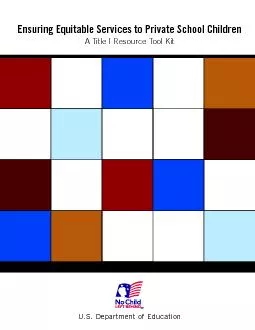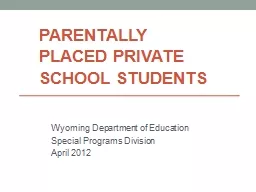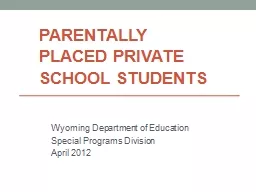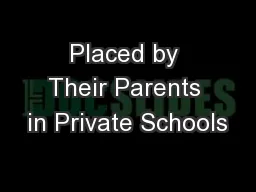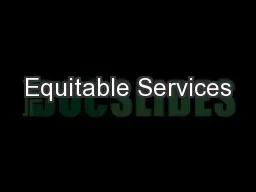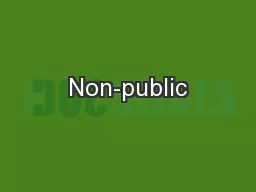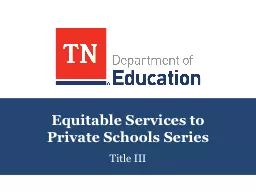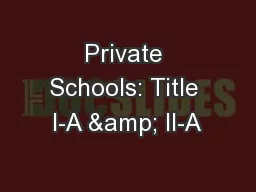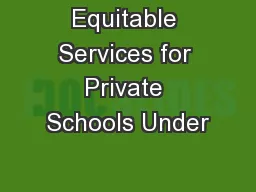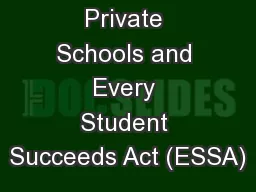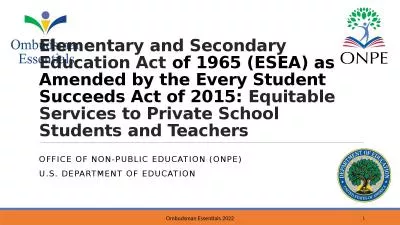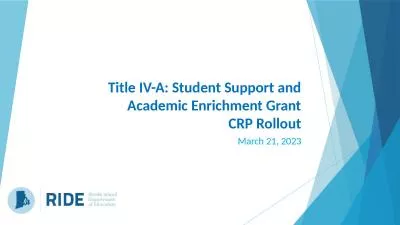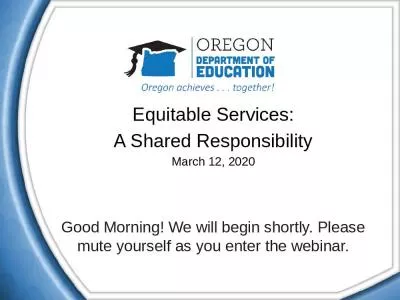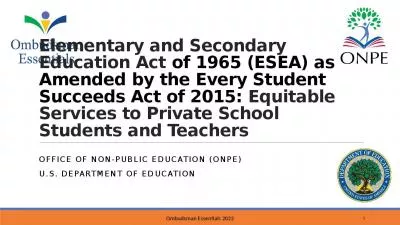PDF-Ensuring Equitable Services to Private School Children
Author : min-jolicoeur | Published Date : 2017-03-08
A Title I Resource Tool Kit US Department of Education This tool kit was produced under the US Department of Education146s Contract No ED04D00061 with ESI Virginia
Presentation Embed Code
Download Presentation
Download Presentation The PPT/PDF document "Ensuring Equitable Services to Private S..." is the property of its rightful owner. Permission is granted to download and print the materials on this website for personal, non-commercial use only, and to display it on your personal computer provided you do not modify the materials and that you retain all copyright notices contained in the materials. By downloading content from our website, you accept the terms of this agreement.
Ensuring Equitable Services to Private School Children: Transcript
A Title I Resource Tool Kit US Department of Education This tool kit was produced under the US Department of Education146s Contract No ED04D00061 with ESI Virginia Berg served as the contrac. USDE Audit Findings. Consultation. Eligibility Criteria . Equitable Services . 3. rd. -party Contracts. Program Evaluation. Inventories. Name. LEA. Number of PNPs. How long have you been working with PNPs?. Wyoming Department of Education. Special Programs Division. April 2012. A Fundamental Right. Undeniable truth:. Children with disabilities eligible under the IDEA have the right to FAPE.. Corresponding duty:. Wyoming Department of Education. Special Programs Division. April 2012. A Fundamental Right. Undeniable truth:. Children with disabilities eligible under the IDEA have the right to FAPE.. Corresponding duty:. Serving Children with . Disabilities. updates. Previously addressed. Child find. Provision of services. Consultation process. Calculation of proportionate share. Equitable services. New topics. Location of Services and Transportation. What you need to know to participate in 2017–18. Webinar. Monday, March 13. Paula Moore. Director, Title I, part A/LAP/CPR. The Office of Superintendent of Public Instruction (OSPI) is currently implementing the Equitable Services provisions of the Every Student Succeeds Act (ESSA). Some parts are still under development.. Schools. Equitable Share and Participation. May 2017. Impacts to Federal Funding. IDOE released a memo. . sharing federal funding updates and information on the equitable share. Access the memo at . Title III. Keith Woodruff. Equitable Services and Charter Schools Coordinator. Consolidated Planning & Monitoring. Keith.Woodruff@tn.gov. (615) 741-3385. Agenda. Equitable Services. Consultation. Equitable Services to Private Schools. Russ Sweet . Team Lead, Federal Systems Team. Oregon Department of Education. Odyssey Conference August 2016. Today’s Objectives. Private Schools under Every Student Succeeds Act (ESSA). Title II, Part A. Virginia Department of Education. Office of Program Administration and Accountability. February 28, 2017. Disclaimer: The presentation was planned under a grant from the U. S. Department of Education (USED). However, the content does not necessarily represent the . September 8, 2017. Russ Sweet. Interim Private School Ombudsman. Today’s Agenda. Introductions. Private School Regulations under Title I-A and Title VIII (Uniform Provisions). Oregon’s response to the regulations. . of 1965 (ESEA) as Amended by the Every Student Succeeds Act of 2015:. Equitable Services to Private School Students and Teachers. Office of Non-Public Education (ONPE). U.S. department of Education. CRP Rollout. March 21, 2023. Agenda. . Program Overview . Equitable Services. CRP Application. Budget . Data Reporting. Resources to Share. Agenda. Program Overview . Equitable Services for Private School . Equitable Services:. A Shared Responsibility. March 12, 2020. ODE Team. Deb Lange, Director . . deb.lange@state.or.us. . . Joni Gilles, . Ombudsman . . . joni.gilles@state.or.us. . . of 1965 (ESEA) as Amended by the Every Student Succeeds Act of 2015:. Equitable Services to Private School Students and Teachers. Office of Non-Public Education (ONPE). U.S. department of Education.
Download Document
Here is the link to download the presentation.
"Ensuring Equitable Services to Private School Children"The content belongs to its owner. You may download and print it for personal use, without modification, and keep all copyright notices. By downloading, you agree to these terms.
Related Documents

